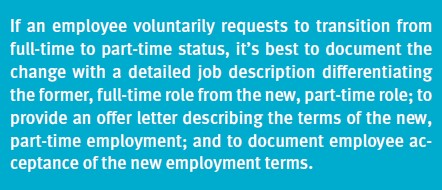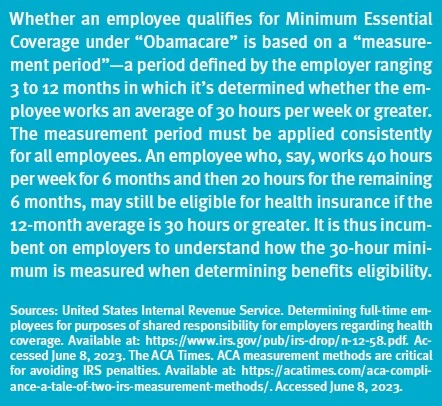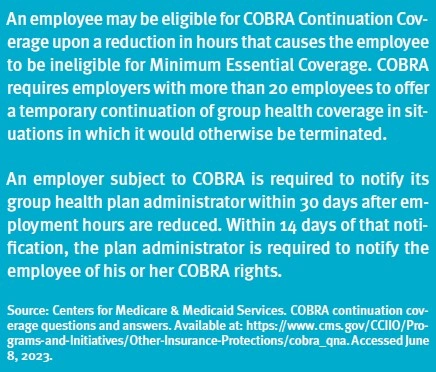Published on
Urgent message: Whether due to reduced staffing needs or employee preference, some employees in urgent care are no longer scheduled for full-time hours. Changing from full-time to part-time status, however, may have consequences beyond simply working fewer hours.
There are any number of reasons why an urgent care owner or operator might want to change the status of an employee from full-time to part-time. Generally speaking, an employer is permitted to do so for any reason whatsoever.1
Pros of Hiring Part-Time Employees
There are a number of benefits to hiring part-time employees, including:
- Lower overhead costs
- Flexibility
- Added support
- Cross-training
- Balanced employees2
The IRS states that “full-time” is at least 30 hours per week or 130 hours per month.3,4 Employers should understand, however, that this definition is for statistical purposes and is not the legal definition. Further, urgent care owners should note that the Fair Labor Standards Act (FLSA) does not define full-time employment or part-time employment at all.5 This is a matter generally to be determined by the employer. Whether an employee is considered full-time or part-time does not change the application of the FLSA, nor does it affect application of the Service Contract Act or the wage and fringe benefit requirements of the Davis-Bacon and Related Acts.5
Full-Time vs Part-Time
Employers must comply with many more requirements for full-time employees than they do for part-time workers. For example, full-time requires that the employer provide Affordable Care Act-compliant health insurance (minimal essential coverage).6 Also, the FLSA—which governs federal wage-and-hour laws—does not cover part-time employment.
There are, however, regulations promulgated pursuant to the statute concerning minimum wage and overtime pay, along with exempt and nonexempt employee classification.
The Patient Protection and Affordable Care Act employers with more than 50 employees to offer employees who work 30 or more hours per week health insurance benefits to avoid employer penalties.7,8 “Small businesses,” those with less than 50 employees, have more discretion in defining coverage eligibility for employees working less than full time and should ensure that the health insurance plan documents are clear regarding benefit eligibility.9 In addition, benefits eligibility when employees’ hours are reduced can be regulated by both internal policy and law, and the urgent care owner should consult with their benefits administrator and legal counsel when defining benefits eligibility in their policies and insurance plan documents.9 Nonetheless, the law doesn’t infringe upon an employer’s rights to determine employee schedules.10

Another rule to note is that if a nonexempt hourly or salaried part-time employee works more than 40 hours in a workweek, the employer must pay them overtime.1 A part-time employee can be nonexempt and salaried. This means that they are eligible for overtime, despite receiving a salary. An employer can adjust the salary to reflect the diminished job responsibilities; however, it can’t be less than the federal or state minimum hourly wage. The part-time salary can be based on a fixed number of work hours for the week, or a fluctuating workweek where the work hours vary from week to week.1
Significantly, it’s usually the employer’s decision as to what represents full-time and part-time status within the company. Ultimately, the determination is based on the requirements for the position.11
At-Will Employment
This discussion should also be framed around the concept of at-will employment. “Employment at-will” means that an employer can fire an employee at any time for any reason (except an illegal one). The employer can also terminate a worker for no reason without incurring legal liability.12
In addition, at-will employment also means that an employer can modify the terms of the employment relationship with no notice and no consequences. An employer, therefore, can alter wages, terminate benefits, or reduce paid time off.12 However, there are three exceptions to the at-will employment doctrine:
- The public-policy exception. Under this exception to employment at will, an employee is wrongfully discharged when the termination is against an explicit, well-established public policy of the State.13 This is the most widely accepted exception and is recognized in nearly every state.14
- The implied-contract exception. This exception applies when an implied contract is formed between an employer and employee, even though no express, written document concerning the employment relationship exists.13
- The covenant-of-good-faith exception. The most dramatic alteration from the traditional employment-at-will doctrine, this exception implies a covenant of good faith and fair dealing into every employment relationship.14 This has been interpreted to mean either that employer personnel decisions are subject to a “just cause” standard or that terminations made in bad faith or motivated by malice are prohibited.14
Again, employers typically can change an employee’s schedule from full-time status to part-time status at any time for any reason.15 Most states require employers to provide some type of advance notice when moving from full-time status to part-time status means a loss of wages.16 The notice requirements are discussed below.
What Must Occur When an Employee Is Reclassified as Part-Time from Full-Time?

Again, employers generally have free reign as far as employing workers, retaining employees, and reducing employee hours and pay. Employers can legally move an employee from full-time status to part-time status for any reason, including the company no longer wanting to employ full-time workers.17
A state may require an employer to notify employees in advance of changes to their employment status, pay rate, or work schedule. As a result, urgent care owners should consult legal counsel before switching an employee from full time to part time.1 For example, in Maryland, in the absence of an employment contract, agreement or policy which states otherwise, an employer may shorten or lengthen an employee’s work hours, or change the shift or times for employment at any time at the employer’s discretion.18
Courtesy Notice. Owners and managers should consider extending the professional courtesy of giving advance notice of changing an employee’s status from full time to part time. This may preserve mutual respect between the parties.17

Required Notice. Under certain circumstances, an employer is required to give 60 days’ notice to legally move an employee from full-time to part-time status. The Worker Adjustment and Retraining Notification (WARN) Act mandates a 60-day advance notice when an employer cuts working hours by 50%. The rule applies when the change impacts 50 or more workers for a minimum of 6 months.17
Takeaway
Unless there is an employment contract or bargaining agreement, an urgent care owner can legally reduce an employee’s work hours or cut pay without liability or recourse by the employee.
However, to best protect themselves, employers should establish personnel policies that speak to all key aspects of hiring, employment, discipline, and termination; moreover, they should make certain that their policies comply with applicable federal, state, and local laws. The personnel policies can be part of an employee handbook that should be distributed to all employees.
REFERENCES
- Ferguson G. A guide to moving an employee from full time to part time. Zenefits.com Available at: https://www.zenefits.com/workest/a-guide-to-moving-an-employee-from-full-time-to-part-time/. Accessed November 18, 2021.
- Waltower S. Hiring full-time vs. part-time employees. Business News Daily. April 3, 2023. ( Available at: https://www.businessnewsdaily.com/15815-full-time-vs-part-time-employees.html. Accessed June 8, 2023.
- United States Internal Revenue Service. Identifying full-time employees. Available at: https://www.irs.gov/affordable-care-act/employers/identifying-full-time-employees. Accessed June 8, 2023.
- U.S. Bureau of Labor Statistics. Labor force statistics from the current population survey. Available at: https://www.bls.gov/cps/definitions.htm. Accessed June 8, 2023.
- U.S. Department of Labor. Full-time employment. Available at: https://www.dol.gov/general/topic/workhours/full-time. Accessed June 8, 2023.
- 6. Centers for Medicare & Medicaid Services. Minimal essential coverage. Available at: https://www.cms.gov/cciio/programs-and-initiatives/health-insurance-market-reforms/minimum-essential-coverage. Accessed June 8, 2023.
- United States Internal Revenue Service. Affordable Care Act provisions for large employers. Available at: https://www.irs.gov/affordable-care-act/employers/affordable-care-act-tax-provisions-for-large-employers. Accessed June 8, 2023.
- United States Internal Revenue Service. Affordable Care Act tax provisions for employers. Available at: https://www.irs.gov/affordable-care-act/employers. Accessed June 8, 2023.
- SHRM, the Society for Human Resource Management. How are benefits impacted when an employee’s hours are reduced? Available at: https://www.shrm.org/resourcesandtools/tools-and-samples/hr-qa/pages/reductioninhours.aspx. Accessed June 8, 2023.
- EEOC v. AutoZone, Inc., 2022 U.S. Dist. LEXIS 179912, at *7 (N.D. Ill. Sep. 30, 2022).
- Watson v. Kijakazi, No. 4:20-CV-1144 PLC, 2023 U.S. Dist. LEXIS 21207, at *37-38 (E.D. Mo. Feb. 8, 2023).
- National Conference of State Legislatures. At-will employment—overview. Updated April 15, 2008. Available at: https://www.ncsl.org/labor-and-employment/at-will-employment-overview. Accessed June 8, 2023.
- Muhl CJ. The employment at-will doctrine: three major exceptions. Monthly Labor Review. January 2001. Available at: https://www.bls.gov/opub/mlr/2001/01/art1full.pdf. Accessed June 8, 2023.
- Watts S. What is at-will employment? Homebase. December 28, 2022. Available at: https://joinhomebase.com/blog/at-will-employment-exceptions/#post-grid. Accessed June 8, 2023.
- UpCounsel. At will employment states: everything you need to know. Available at: https://www.upcounsel.com/at-will-employment-states. Accessed June 8, 2023.
- Carma Developers, Inc. v. Marathon Dev. Cal., Inc..
- Mayhew R. Legally moving an employee from full-time to part-time status. Biz Fluent. September 26, 2017. Available at: https://bizfluent.com/info-12086128-legally-moving-employee-fulltime-parttime-status.html. Accessed June 8, 2023.
- Maryland Division of Labor and Industry, Department of Labor. The Maryland Guide to Wage Payment and Employment Standards. Available at: https://www.dllr.state.md.us/labor/wagepay/mdguidewagepay.pdf. Accessed June 8, 2023.
Download the article PDF: Changing an Employee from Full-Time to Part-Time Status
Read More
- Five Federal Employment Regulations Urgent Care Operators Need To Know (Part 1)
- Five Federal Employment Regulations Urgent Care Operators Need To Know (Part 2)
- Considerations For Urgent Care Operators On Equal Pay Legislation And Enforcement

